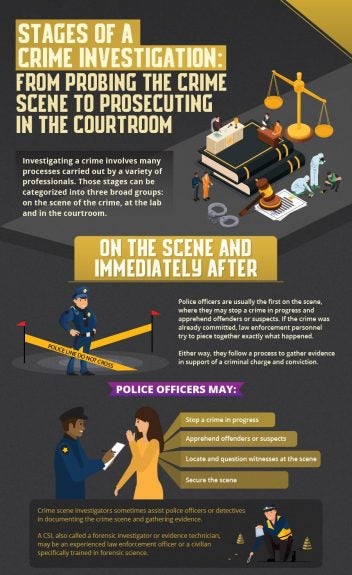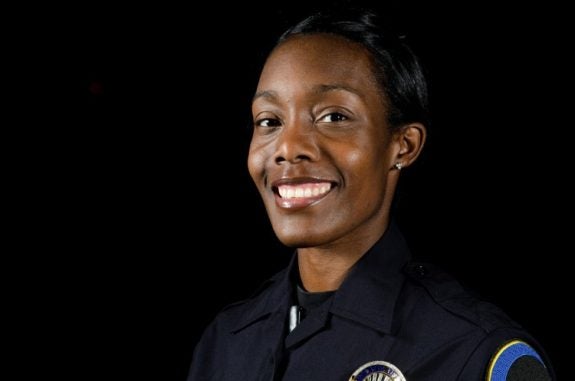The police procedural has been a popular film and TV genre for decades, providing viewers with the chance to vicariously solve crimes and administer justice along with their favorite fictional detectives. Many of these programs not only feature savvy sleuths and crime-fighting street cops, but also showcase the behind-the-scenes work of crime analysts.
Shows like CSI: Crime Scene Investigation have put crime analysts at center stage. The question is: How do these TV depictions compare with the profession’s real-world responsibilities? In this article, we will explain the scope of duties that actual crime analysts take on and contrast those actual duties with some of what is shown on film and TV.
The Crime Analyst Role on TV
What is a crime analyst, exactly? The answer you will get from a TV show differs markedly from the one you will get from real-world police professionals. While shows such as CSI: Crime Scene Investigation highlight the important role that crime analysts play in solving crimes and building evidence-based legal cases, they get many of the details wrong.
Errors and Inaccuracies
Consider just a few ways that police procedurals tend to misrepresent crime analysts.
- On TV, crime analysts tend to have a treasure trove of high-tech computer equipment. In real life, taxpayers fund crime analysis departments, and the departments often have limited resources to acquire and develop these technology portfolios.
- TV shows often depict a single analyst surveying a crime scene, finding a compelling piece of evidence and reaching a revelatory conclusion. In real life, crime analysis is more team oriented; many specialists work together in a system with plenty of checks and balances.
- While TV shows depict crimes being solved quickly, the reality is that crime analysis takes time. What happens in minutes on TV may take days or even weeks in real life.
Real-World Effects
Fictional depictions of crime analysis have had a pronounced impact on real-world criminal justice practices, particularly through what’s known as the “CSI effect.” This describes a phenomenon in which jurors, impacted by what they’ve seen on TV, demand a high level of forensic evidence before ruling on a case. Often, they create an evidence threshold that is simply unrealistic or unnecessary, complicating prosecutors’ work.
The Real Role of a Crime Analyst
If your crime analysis knowledge comes entirely from TV, the reality may surprise you. Consider the real role that crime analysts play in law enforcement.
Job Description
Crime analysts are tasked with studying criminal behavior patterns, leading to proactive law enforcement strategies that can stop crimes before they occur. The strategies are developed through systematic, analytical and scientific reviews of the available evidence, providing data that police departments can use to strategically allocate resources and personnel.
Crime analysts may work with teams of police investigators to help solve outstanding cases or prevent future crimes. Those cases may vary in nature. Sometimes, the work of the crime analyst may be to help locate a civilian who has gone missing. In other cases, their work may involve identifying local patterns of drug trafficking, helping investigators know where to spend their resources to curb criminal activity.
Methods and Tools
“Historically, law enforcement agencies have relied on their own official data to analyze crime trends and identify spatial and temporal hot spots for strategic and tactical operations,” says UCF professor Will Moreto. In pursuit of their goals, crime analysts may integrate computer programs, statistical analysis and forensic examination to gain a better understanding of criminal patterns. Crime analysts may also create perimeter maps and statistical databases to help monitor local criminals or criminal organizations.
For example, while database programs like CAD are not specifically aimed at crime prevention, they can be invaluable to analysts looking to utilize all the data their police department has gathered to help identify criminal patterns. Tools like Microsoft Excel may be used to track criminal trends and trajectories. “More recently, with the advent of social media,” says Moreto “crime analysts are now able to obtain information and data from popular social media platforms and triangulate this with other data to inform criminal investigations.”
Agency Management Systems are also important; these programs allow crime analysts to coordinate their findings with other departments or police units. As Moreto points out, “There has been growth in inter-agency data sharing and collaboration, particularly through the use of fusion centers, which provides additional useful data for crime analysis.”
Different Types
Three types of analysis dominate the field:
- Tactical analysis. Tactical analysis provides data that assists operations personnel (investigators and patrol officers) in identifying specific, immediate crime patterns or trends in the area.
- Strategic analysis. Strategic analysis focuses more on long-term problems and on projecting how crime may increase in months or years to come.
- Administrative analysis. Administrative analysis provides social, geographic or financial information to help promote informed decision-making about allocating department resources.
How to Become a Crime Analyst
People interested in pursuing crime analysis careers need to achieve the right educational foundation and cultivate the right skill set.
Educational Requirements
Generally, crime analysts are required to have a minimum of a bachelor’s degree in criminology, criminal justice, or a field related to psychology and sociology. Additionally, coursework in probability, statistics and other mathematical disciplines may be helpful. Having a more advanced degree, such as a master’s degree, can make crime analysts more competitive in the job market.
Essential Skills
Over the course of their education, aspiring crime analysts hone the competencies necessary to be valuable members of law enforcement teams. The foundational skills for crime analysts include the following:
- Technical skills. Knowledge of statistical modeling programs and databases can be especially helpful for projecting criminal activity trends.
- Analytical skills. Crime analysts must be ready to evaluate data and draw reasonable inferences.
- Communication skills. Being able to convey their findings and conclusions to other law enforcement professionals is key.
- Presentation skills. Crime analysts may need to give presentations on their findings, particularly to police departments looking to rethink how they allocate resources.
Enrolling in a master’s degree program can help deepen these skills. UCF Online’s criminal justice vertical, which includes an online master’s degree in forensic science and an online crime analysis certificate program, can help students gain expertise in the skills needed to excel in a crime analyst role.
Crime Analyst Salary
The median annual salary for crime analysts is about $69,035, according to data from Glassdoor. However, this figure can be influenced by a number of factors, including the following:
- Experience level. Those who have worked in crime analysis longer will typically earn higher salaries.
- Advanced degree holders will command greater pay.
- Law enforcement departments in larger metropolitan areas often pay higher salaries for crime analysts.
Additionally, some crime analysts may make higher salaries, depending on their employer. For example, salary information from Indeed reports that analysts who work at the FBI can anticipate an average annual salary of around $96,375. Employees working for the FBI also have access to a variety of benefits programs, such as the Federal Employees Health Benefits Program, Federal Long-Term Care Insurance Program, Federal Employees Group Life Insurance Program, Federal Flexible Spending Account Program, and Federal Thrift Savings Plan.
Along with salary, aspiring analysts may also wish to know about the typical work environment. Usually, crime analysts work in either an office or laboratory setting, typically with a team of other analysts. While crime analysts generally don’t go out into the “field” as much as TV shows suggest they do, there may occasionally be a need to conduct on-site interviews or to gather qualitative data that can be used on a current case.
Take the Next Step Toward Becoming a Crime Analyst
If you are eager to learn more about becoming a successful law enforcement professional, specifically through working in crime analysis, a good first step is to get more details about the University of Central Florida’s online criminal justice programs, and specifically the online Master of Science in Forensic Science and crime analysis certificate programs.
Students at UCF receive opportunities to study and partner with organizations like the National Center for Forensic Science (NCFS), a research center that has an 18-year history of close collaboration with the forensic science community. At NCFS, students gain first-hand experience with physical evidence gathering, DNA evidence collection, digital evidence analysis, and more. Additionally, students gain networking opportunities with law enforcement and crime analysis professionals throughout the State of Florida.
Find out more about how UCF’s online criminal justice programs can position you for professional success.







